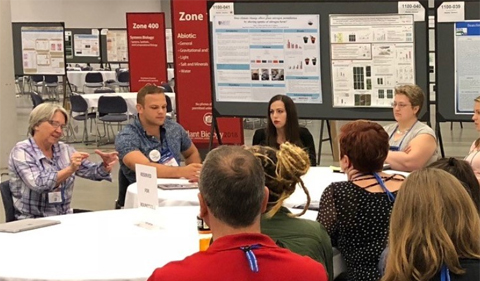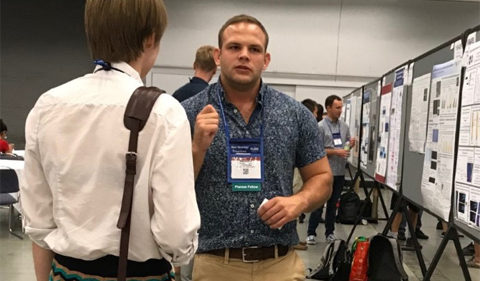
Dr. Sarah Wyatt and graduate student Al Meyers lead a round table discussion on Plant Space Biology.
Dr. Sarah Wyatt, Professor of Environmental & Plant Biology and Director of Molecular and Cellular Biology, along with graduate students Anne Sternberger and Alexander Meyers, traveled to Montreal, Canada, for the joint meeting of the American Society of Plant Biologists, Canadian Society of Plant Biologists/Societe Canadienne de Biologie Vegetale, and the International Society of Photosynthesis Research July 13 – 19.
Members of the Wyatt lab were active participants at this year’s conference, presenting research posters, giving talks and leading round table discussions. Wyatt chairs the Education Committee at ASPB and hosted a workshop on “Integrating Authentic Research into the Classroom.”
Anne Sternberger gave a lightning talk for DNA detective and a poster presentation on her dissertation research: “DNA Detective: Riding the DNA Subway Red Line From Genotype to Phenotype.” Wyatt is her co-author.
Abstract: DNA Detective is a workshop designed to introduce 6-12 grade students to computational biology and bioinformatics using Cyverse’s DNA Subway platform. DNA Subway is a user-friendly workspace for genome analysis and uses the metaphor of a network of subway lines to familiarize users with the bioinformatics steps involved in annotating and comparing DNA sequences. For DNA Detective, the DNA Subway Red Line was used to guide students through analyzing a “mystery” DNA sequence, distinguishing its gene structure / function and identifying the phenotype of its mutant. Students were divided into groups, and each group was assigned a unique Arabidopsis thaliana DNA sequence. Students then “traveled” the Red Line to find and remove sequence repeats, use gene prediction software to structurally annotate their sequence, and search databases of known genes to assign functional annotations to their gene model. Once completed, mutant plants for each Arabidopsis gene were placed in the front of the room, and students were asked to select the mutant defective for their gene. DNA Detective has been presented at two Tech Savvy events, daylong conferences aimed at attracting middle school girls to STEM fields. Through these workshops, students were acquainted to the flow of genetic information from genotype to phenotype and tackled complex genomic analyses in hopes of inspiring and empowering them towards continued STEM education.
Sternberger’s poster was on “Investigating the Environmental and Genetic Mechanisms Involved in the Mixed Breeding System of the North American Violet, Viola pubescens,” with co-authors Megan J. Bowman of Michigan State University; Ohio University graduate student Colin P.S. Kruse; Dr. Harvey E. Ballard, Professor of Environmental & Plant Biology at OHIO; Kevin L. Childs, of Michigan State University; and Wyatt.
Abstract: The environmental parameters impacting seasonal development of chasmogamous and cleistogamous flowers of Viola pubescens were investigated during the summers of 2016 and 2017. V. pubescens produces two distinct flower types at different times of the season: chasmogamous (CH), showy open flowers that are cross-pollinated and generate genetically diverse seeds during the spring, and cleistogamous (CL), bud-like and mechanically closed flowers which force self-pollination in the summer. While separate production of the two flowers is believed to be influenced by environmental factors, neither the environmental cue nor the genetic mechanism that signal for each flower type is known. To investigate the environmental cue, ten quadrats were randomly selected over native populations along a forty meter transect in Sells Park, Athens, Ohio. For each quadrat, measurements of temperature, light quantity, soil moisture, soil pH, canopy openness and the number of CH or CL buds were collected during the spring and summer. Statistical analyses using zero-inflated negative binomials, indicate that temperature and light quantity are significant factors leading to the transition of CH to CL flowers, and Logit probability models for the temperature and light data provide thresholds at which CH or CL flowering is most probable. Additionally, differences in gene expression between CH and CL flowers were observed via differential expression and weighted gene correlation network analyses on RNAseq data for each flower type. Tissue-specific transcriptional networks were identified indicating gene regulation by temperature and light, supporting the environmental data. These data will be used to construct models of the environmental and genetic signaling leading to production of each flower type.
Alexander Myers presented a poster presentation on his dissertation research: “Plant response under fractional gravity.”
His co-authors are Nathan Madonich and Chris Wolverton of Ohio Wesleyan University and Wyatt.
Abstract: A plant’s ability to sense and respond to gravity is critical to its proper growth and development. As humans begin to explore extraterrestrial environments, plants will be a vital source of food and bioregenerative life support. However, the evolution of plants has prepared them only for the 1g conditions of Earth. Gaining an understanding of how plants will grow under the conditions of low earth orbit (0g), Earth’s moon (0.16g), and Mars (0.38g) is critical to the success of human space exploration. EMCS-PGP (European Modular Cultivation System- Plant Gravity Perception) is an experiment designed to assess the physical and transcriptomic effects of fractional gravity on Arabidopsis seedlings. Over 1,200 seedlings were loaded into EMCS seed cassettes and sent to the International Space Station. The cassettes were loaded onto the EMCS rotor, and subjected to centrifugal force equating to g levels between 0.006g to 1g. Root and hypocotyl bending were assessed by still images collected during the experiment. After the experiment the seedlings were frozen and returned to Earth for molecular analysis. Seedlings were dissected into root tip, root, hypocotyl, and cotyledon fractions, their RNA extracted, and sent for sequencing to assess tissue- and gravity-specific transcriptomic effects.





















Comments